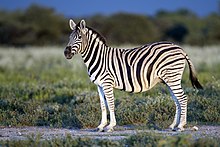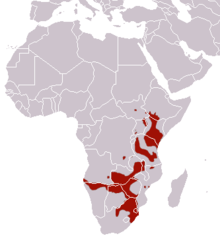| Plains zebra Temporal range: Pleistocene – Recent[1]
| |
|---|---|

| |
| Burchell's zebra (E. quagga burchellii) at Etosha National Park in Namibia | |
| Scientific classification | |
| Domain: | Eukaryota |
| Kingdom: | Animalia |
| Phylum: | Chordata |
| Class: | Mammalia |
| Order: | Perissodactyla |
| Family: | Equidae |
| Genus: | Equus |
| Subgenus: | Hippotigris |
| Species: | E. quagga
|
| Binomial name | |
| Equus quagga Boddaert, 1785
| |
| Subspecies | |
|
E. q. quagga † | |

| |
| plains zebra range | |
| Synonyms[2] | |
| |
The plains zebra (Equus quagga, formerly Equus burchellii) is the most common and geographically widespread species of zebra. Its range is fragmented, but spans much of southern and eastern Africa south of the Sahara. Six or seven subspecies have been recognised, including the extinct quagga which was thought to be a separate species. More recent research supports variations in zebra populations being clines rather than subspecies.
Plains zebras are intermediate in size between the larger Grévy's zebra and the smaller mountain zebra and tend to have broader stripes than both. Great variation in coat patterns exists between clines and individuals. The plains zebra's habitat is generally, but not exclusively, treeless grasslands and savanna woodlands, both tropical and temperate. They generally avoid desert, dense rainforest and permanent wetlands. Zebras are preyed upon by lions and spotted hyenas, Nile crocodiles and, to a lesser extent, leopards, cheetahs and African wild dogs.
Plains zebras are a highly social species, forming harems with a single stallion, several mares and their recent offspring; bachelor groups also form. Groups may come together to form herds. The animals keep watch for predators; they bark or snort when they see a predator and the harem stallion attacks predators to defend his harem.
The plains zebra remains common in game reserves, but is threatened by human activities, such as hunting for its meat and hide, as well as competition with livestock and encroachment by farming on much of its habitat. The loss of open grasslands due to woody plant encroachment increases predation risk and therewith habitat.[3] Plains zebra are listed as near threatened by the IUCN as of 2016. The species population is stable and not endangered, though populations in most countries have declined sharply.[4]
- ^ "Fossilworks: Equus quagga".
- ^ a b King, S.R.B.; Moehlman, P.D. (2016). "Equus quagga". IUCN Red List of Threatened Species. 2016: e.T41013A45172424. doi:10.2305/IUCN.UK.2016-2.RLTS.T41013A45172424.en. Retrieved 19 November 2021.
- ^ Chen, Anping; Reperant, Leslie; Fischhoff, Ilya R.; Rubenstein, Daniel I. (2021-07-01). "Increased vigilance of plains zebras (Equus quagga) in response to more bush coverage in a Kenyan savanna". Climate Change Ecology. 1: 100001. doi:10.1016/j.ecochg.2021.100001. ISSN 2666-9005.
- ^ IUCN (2016-06-20). Equus quagga: King, S.R.B. & Moehlman, P.D.: The IUCN Red List of Threatened Species 2016: e.T41013A45172424 (Report). International Union for Conservation of Nature. doi:10.2305/iucn.uk.2016-2.rlts.t41013a45172424.en.
